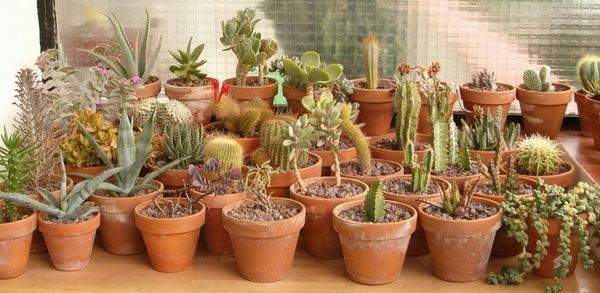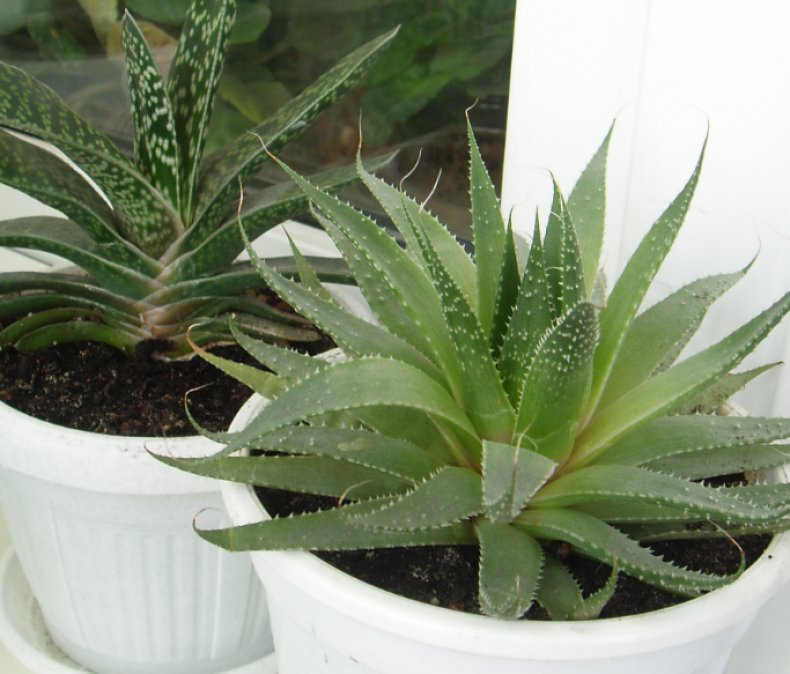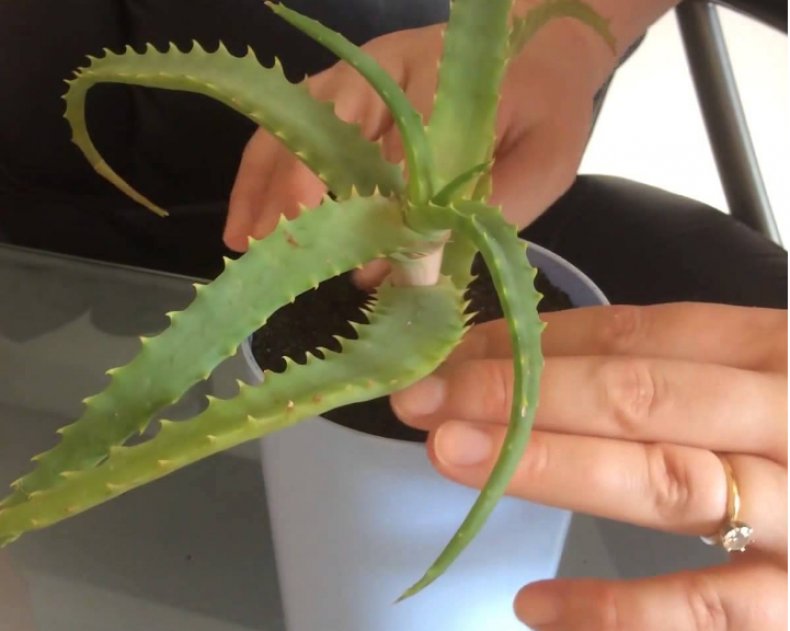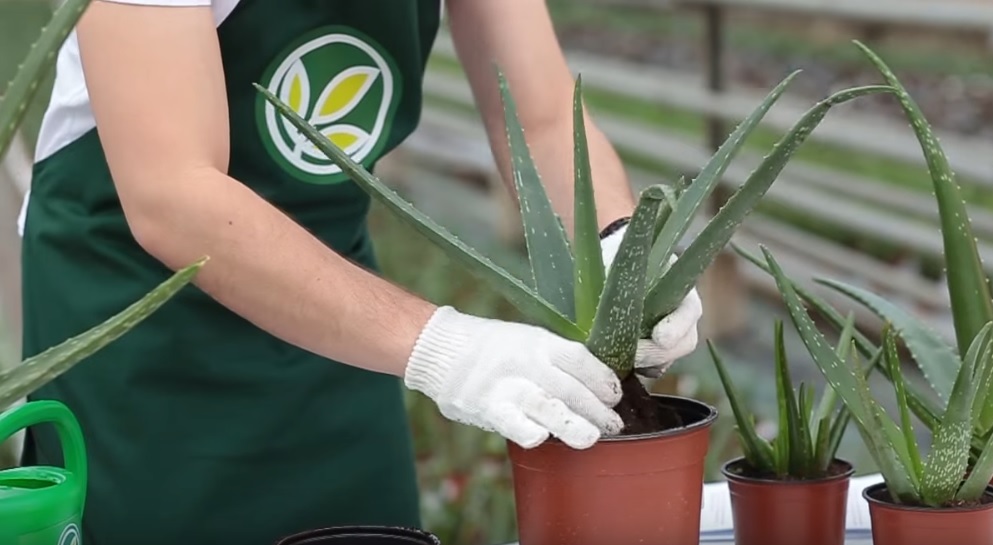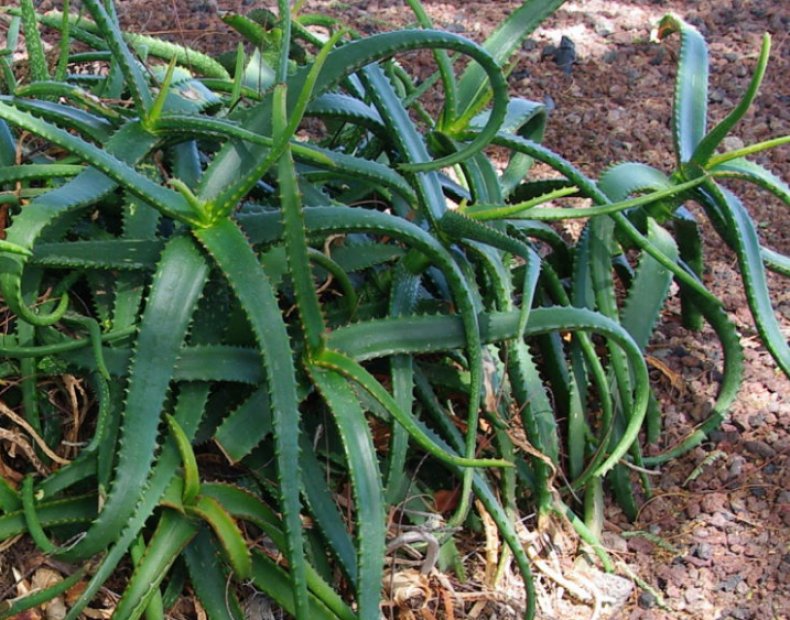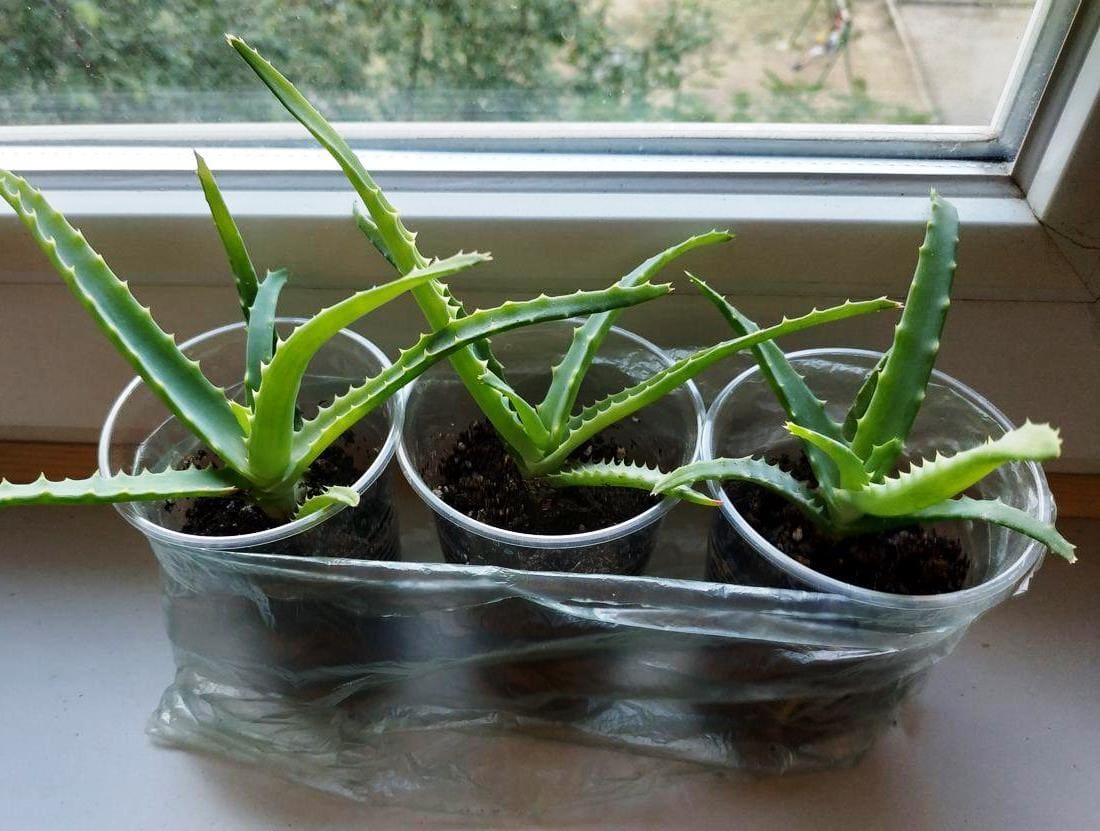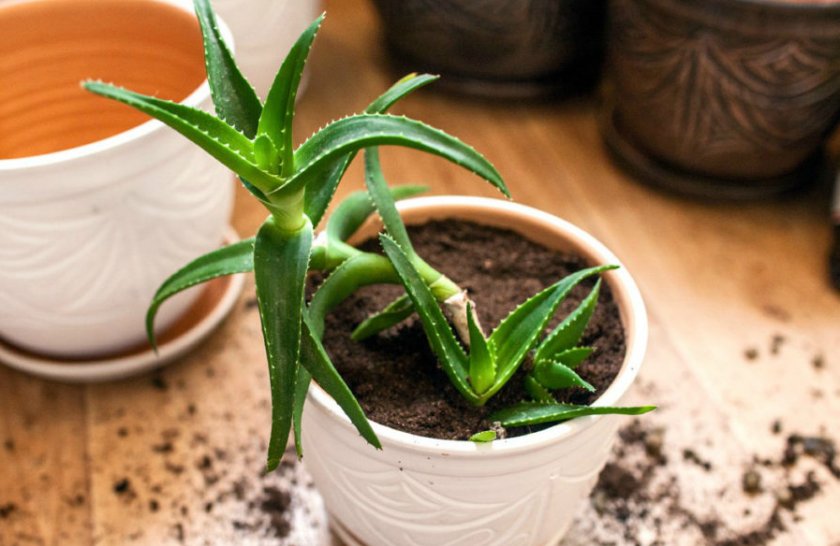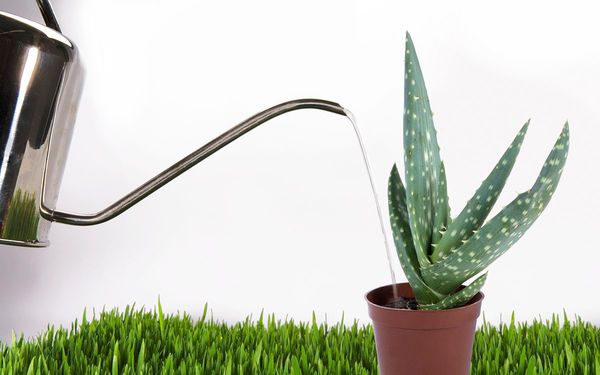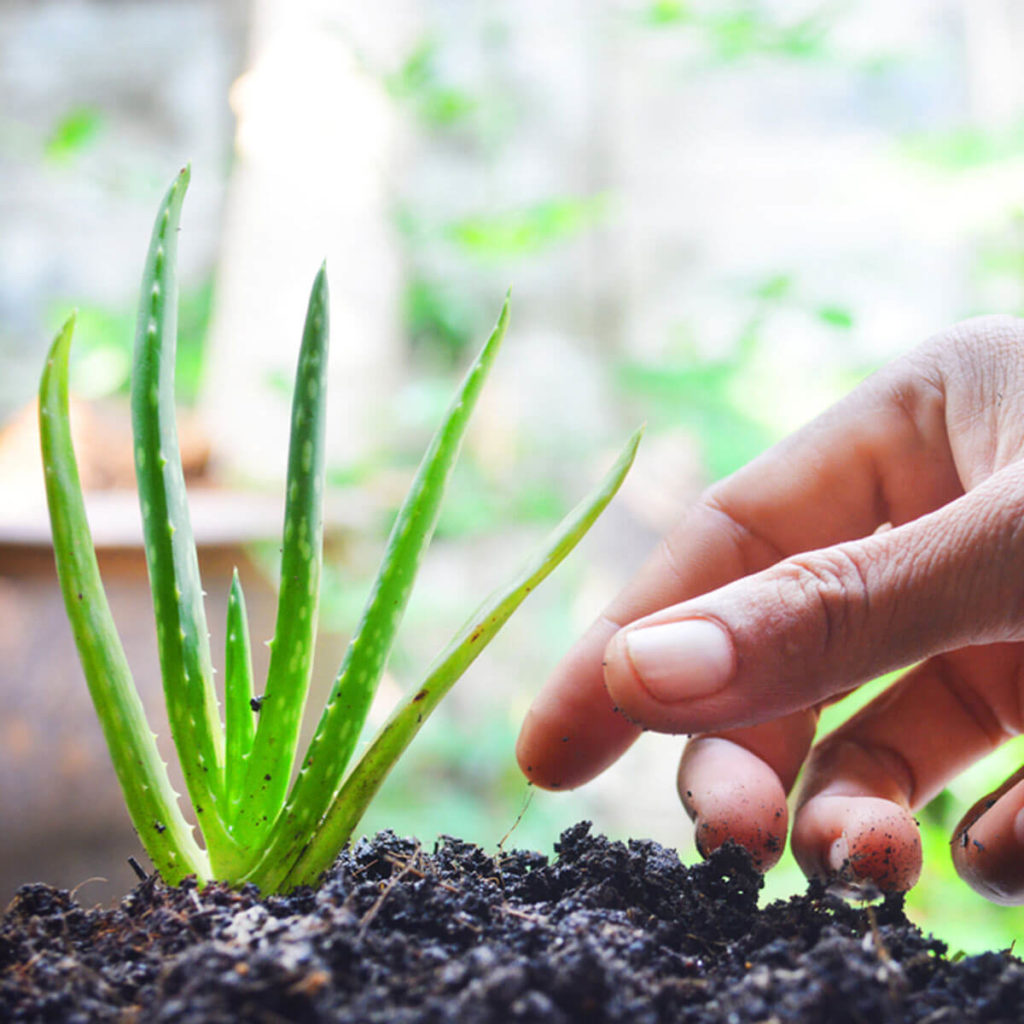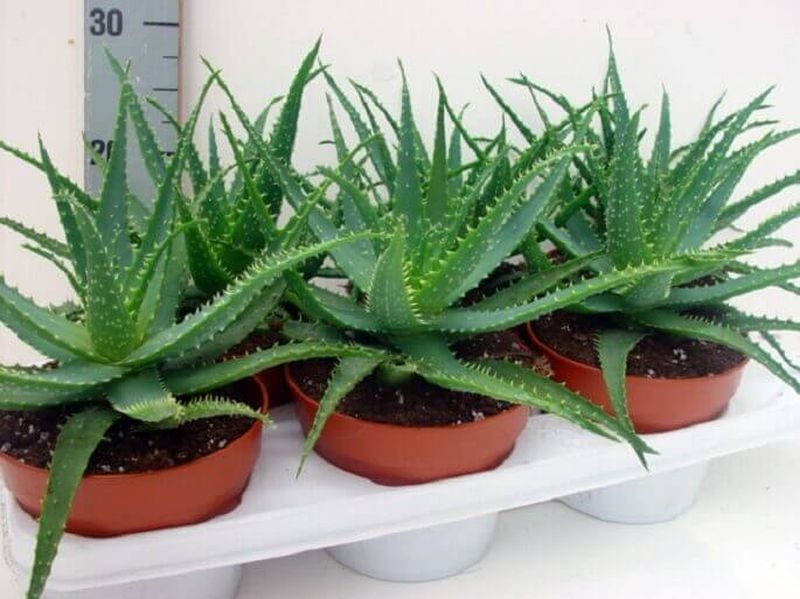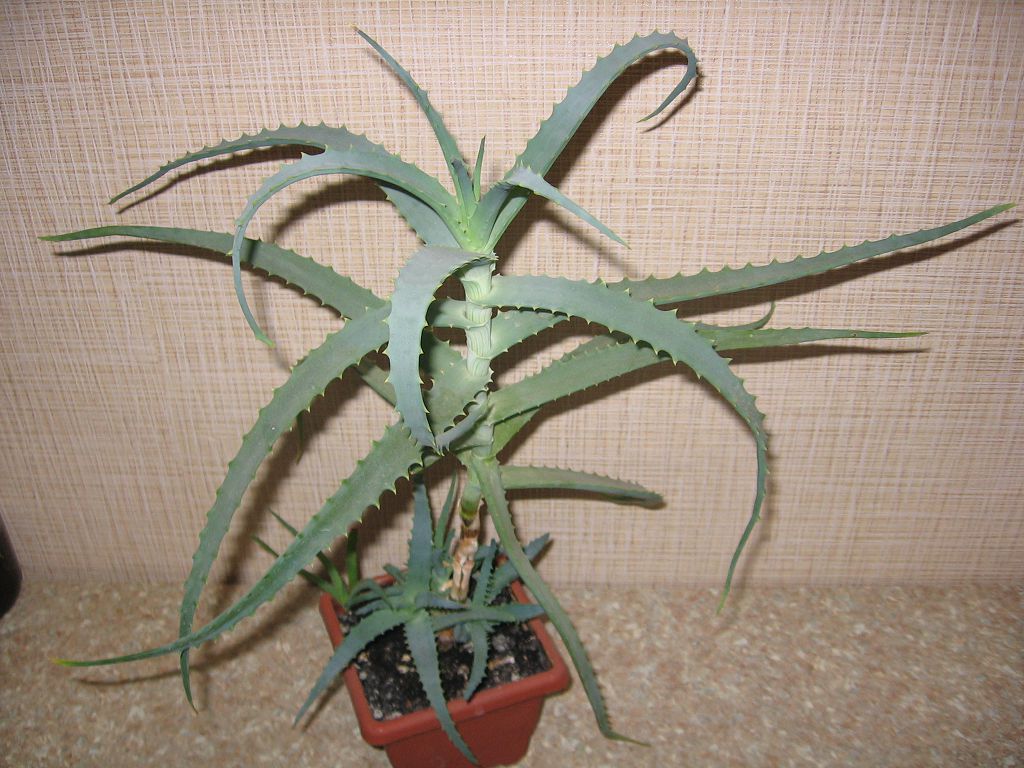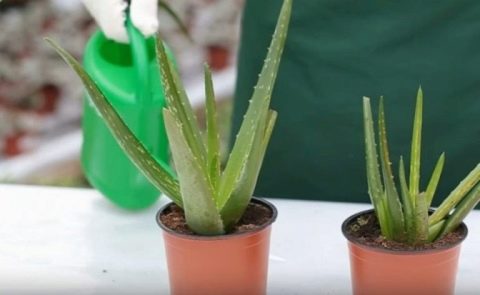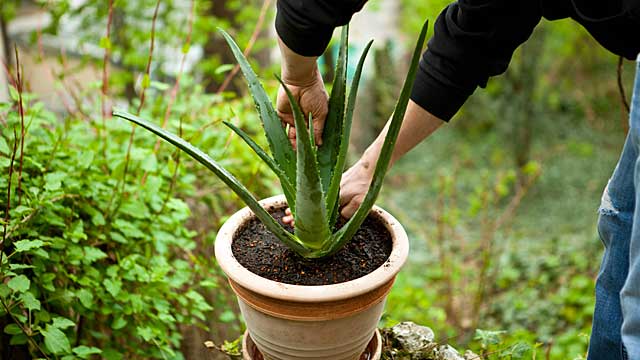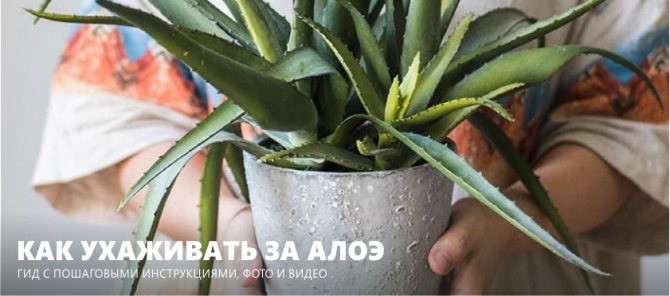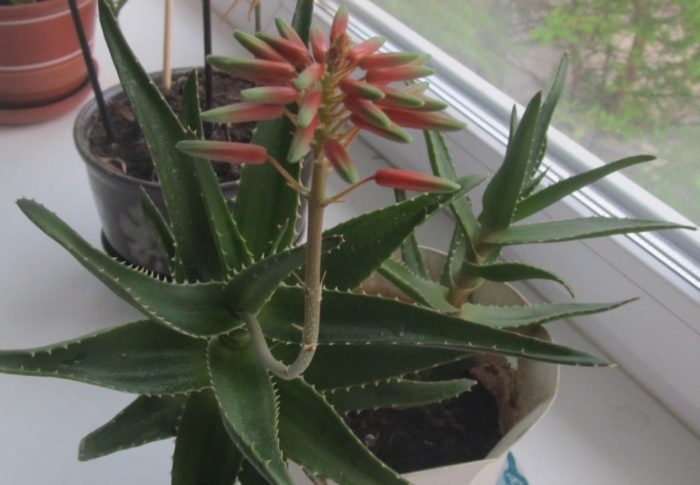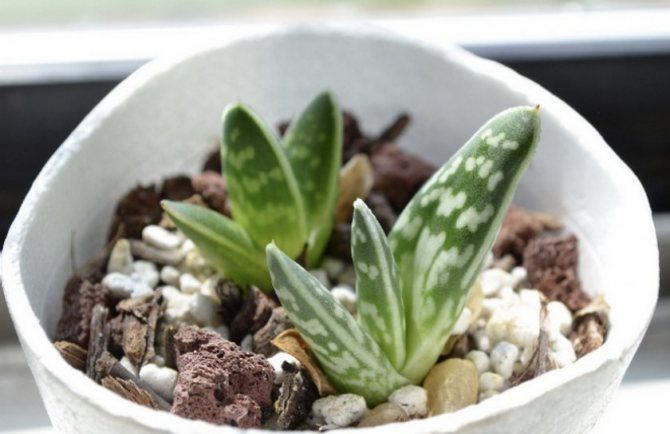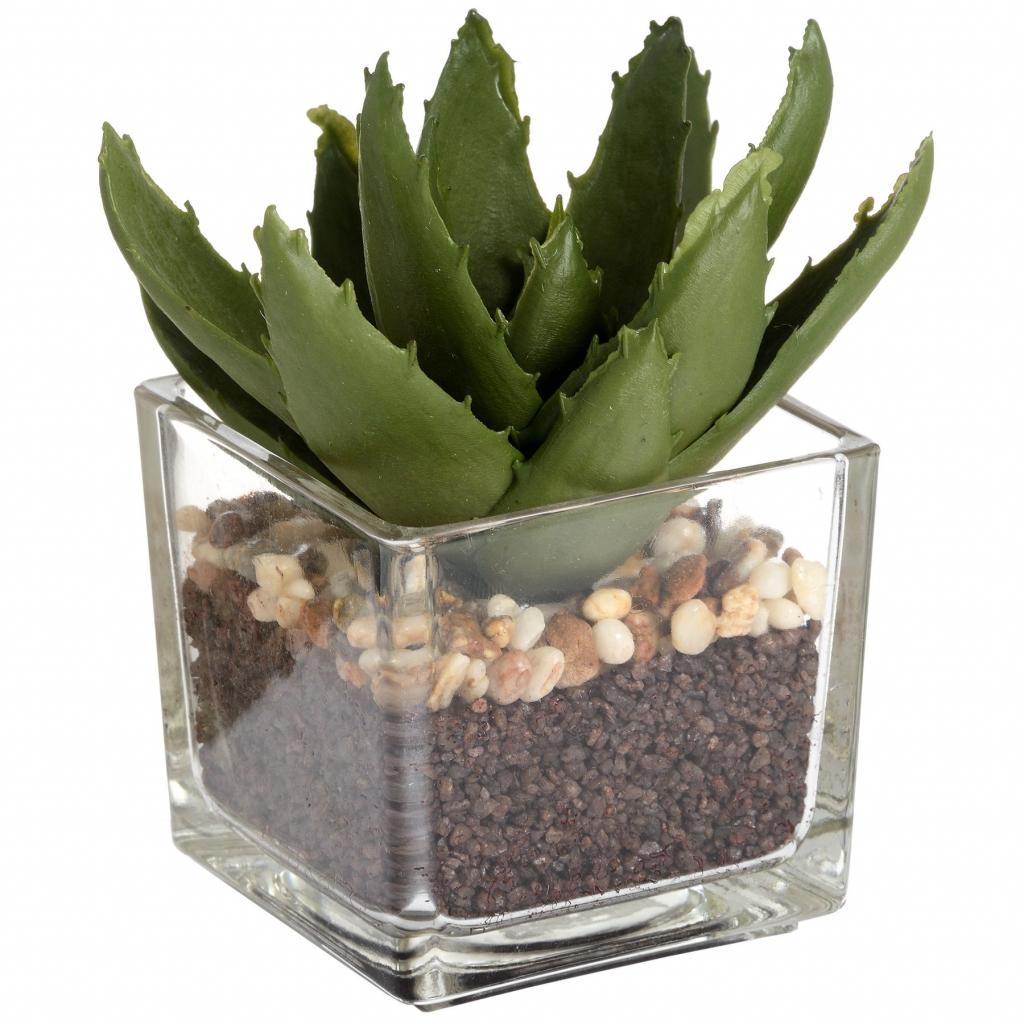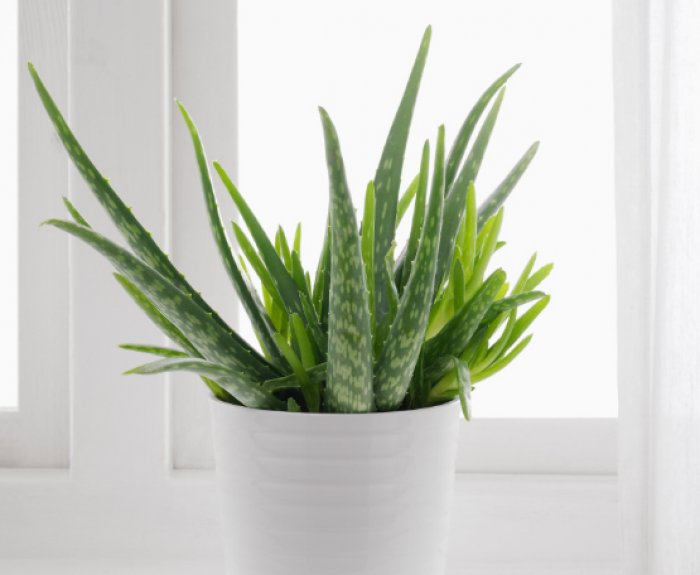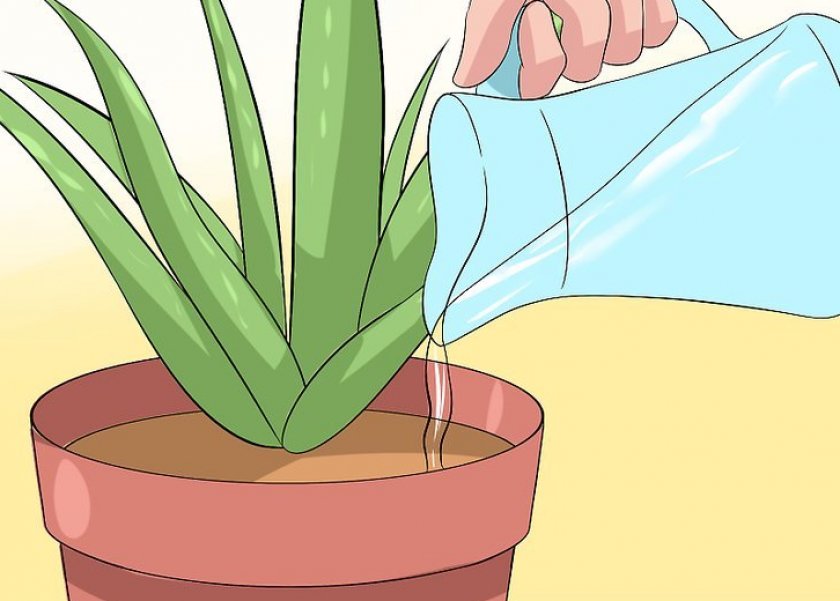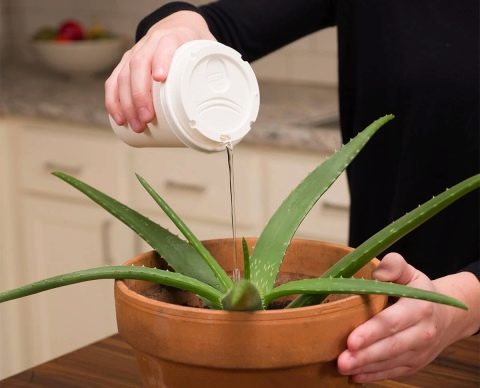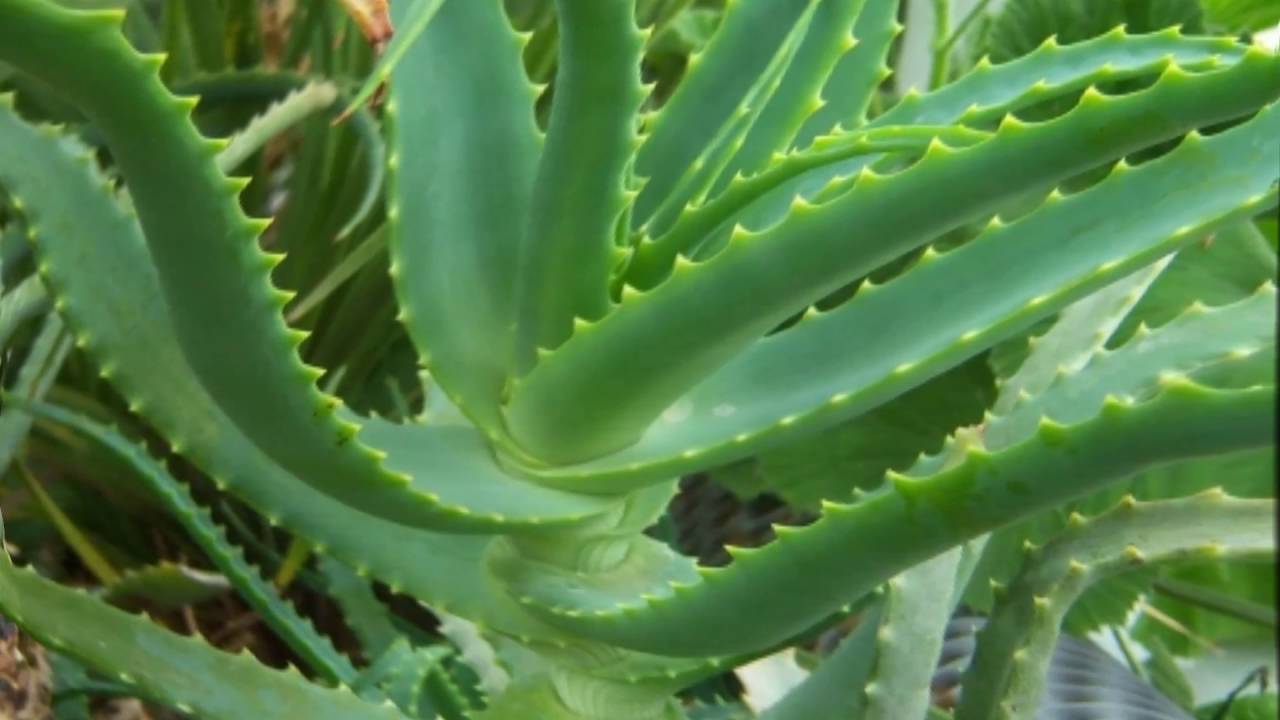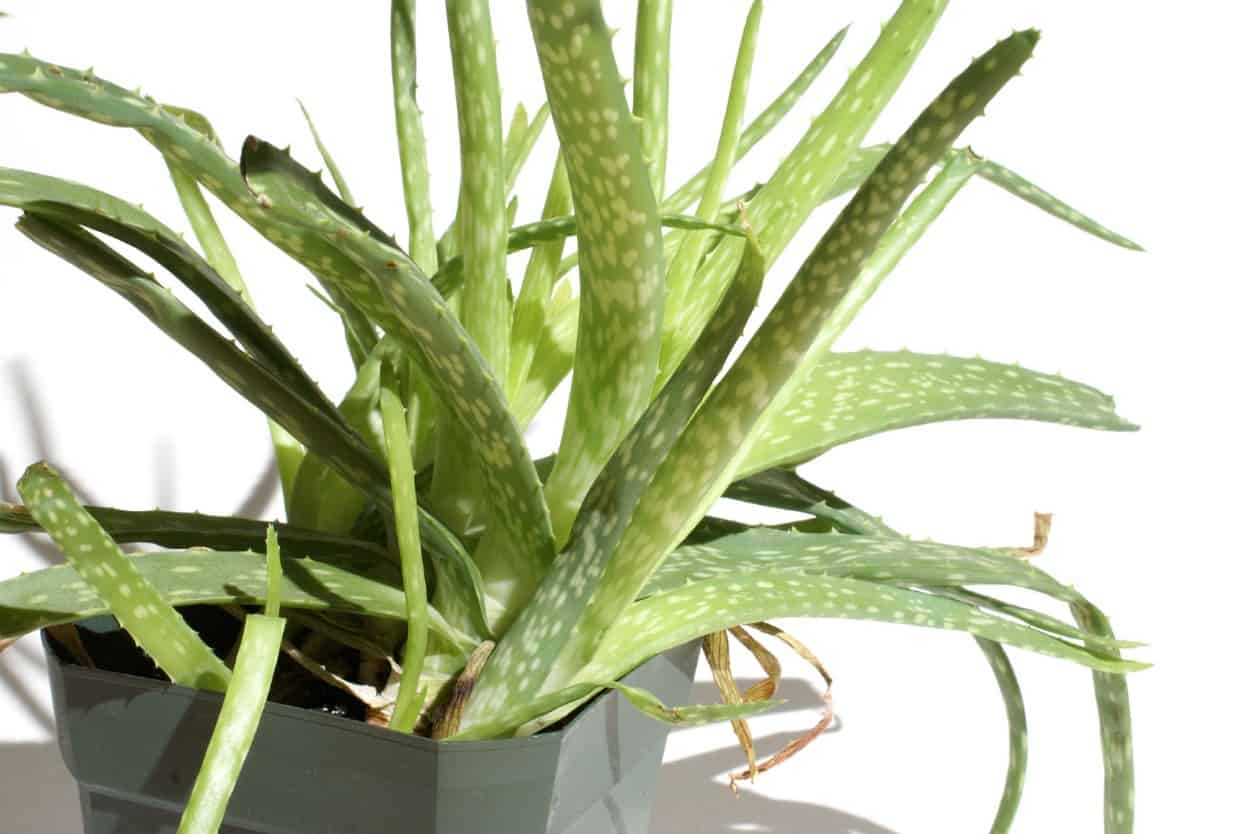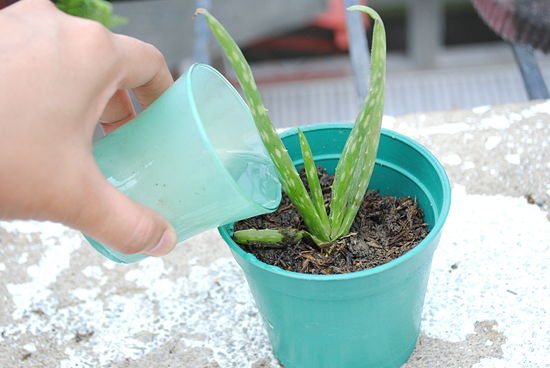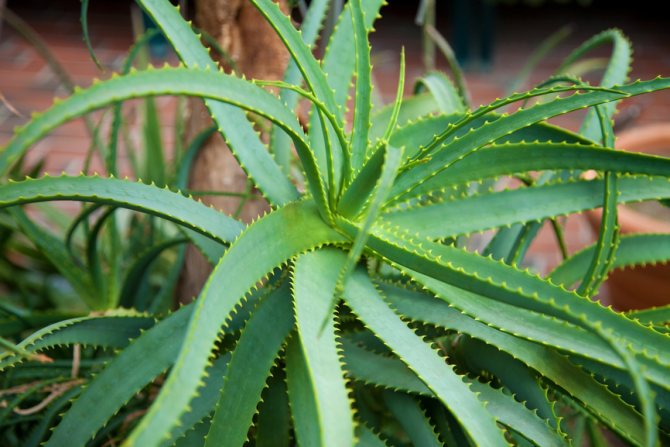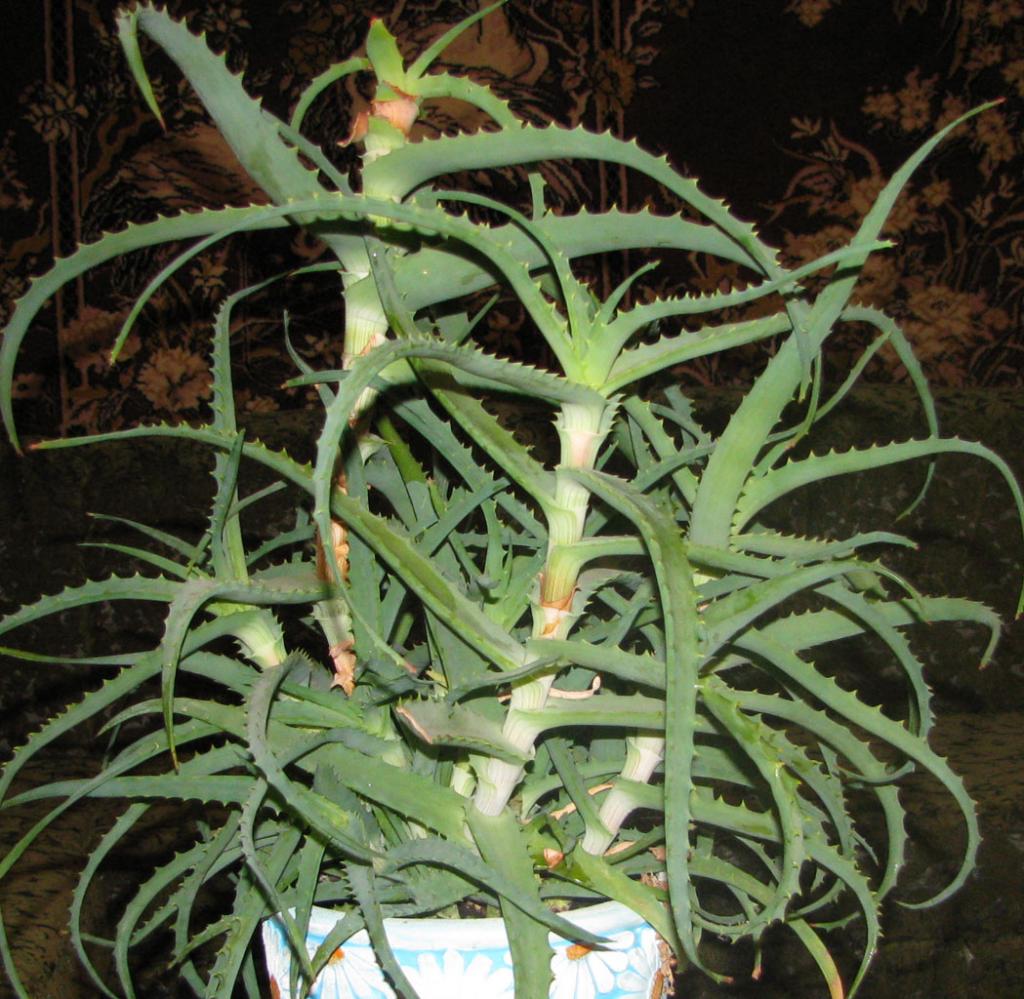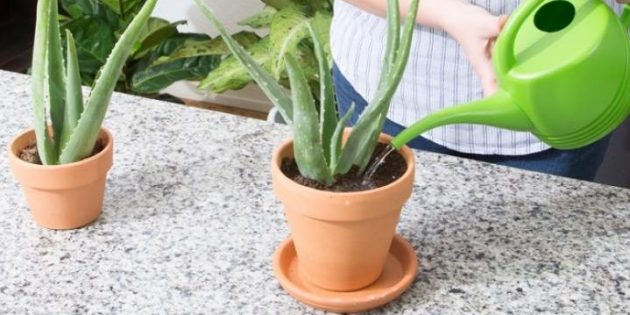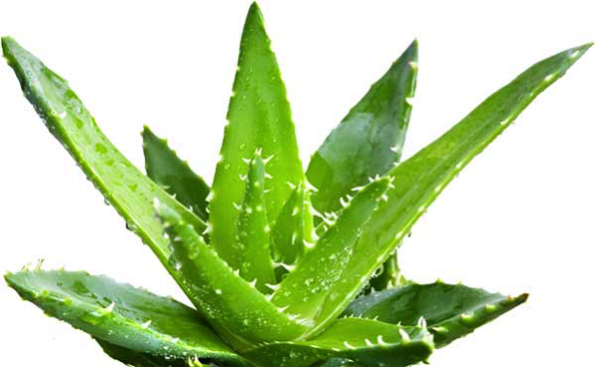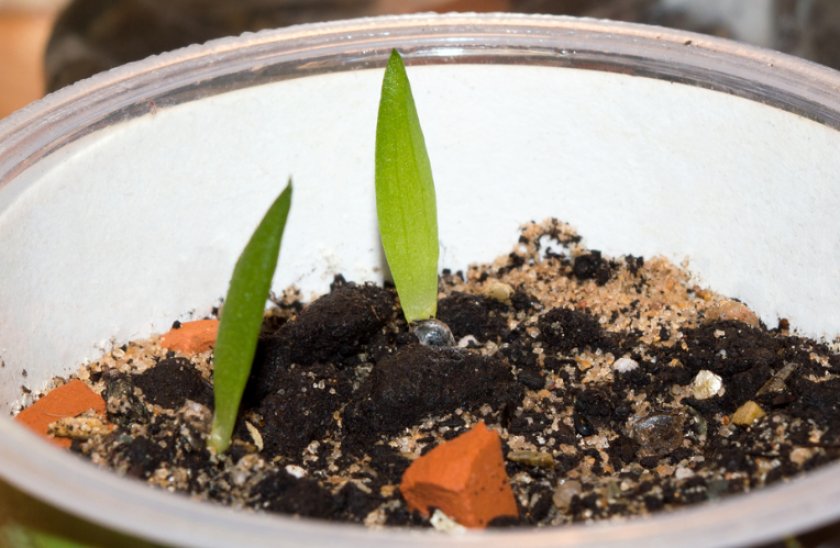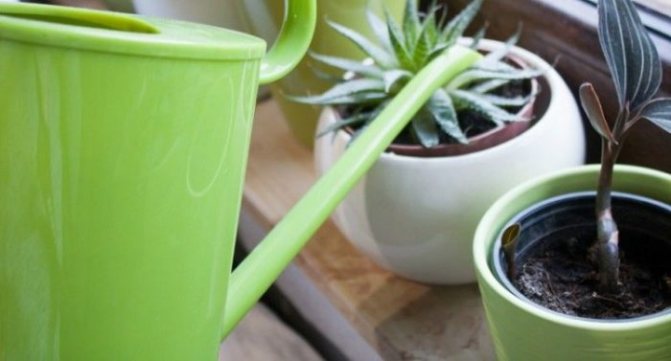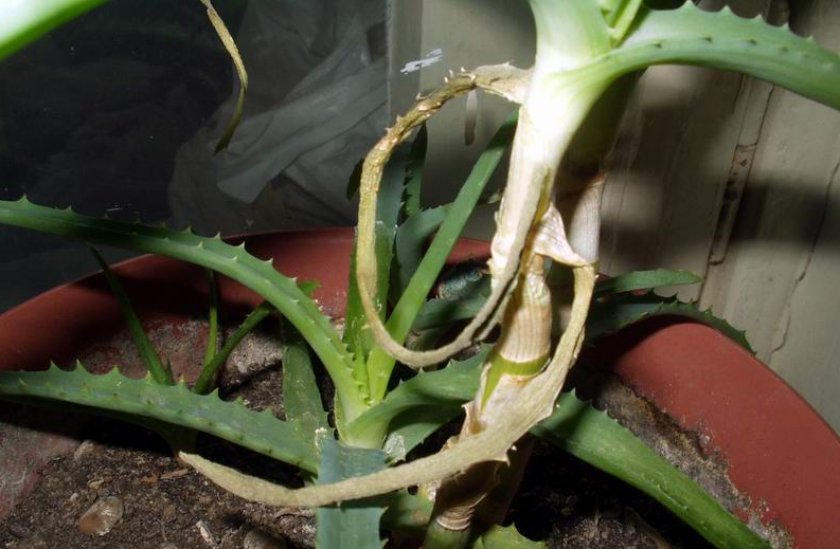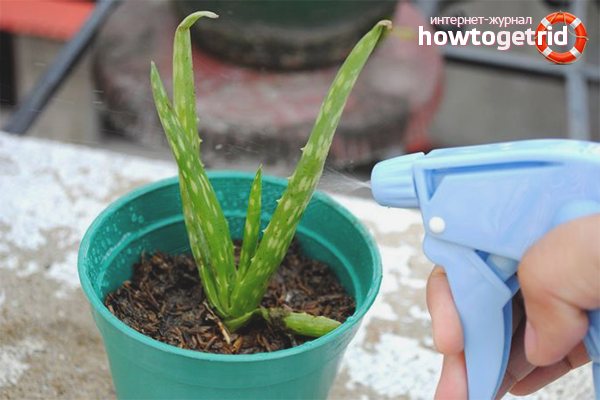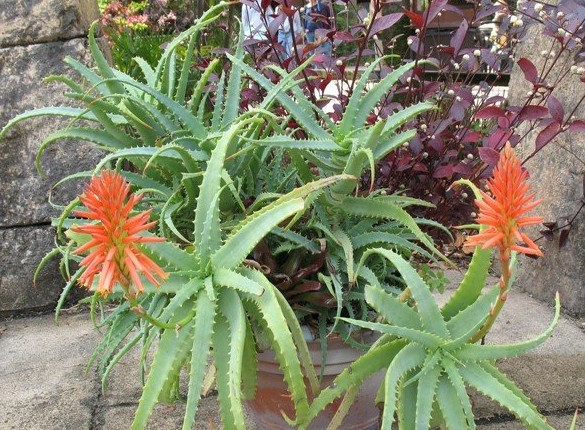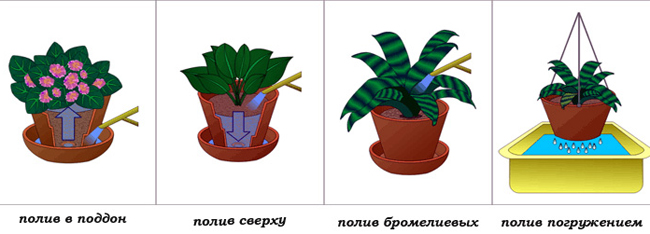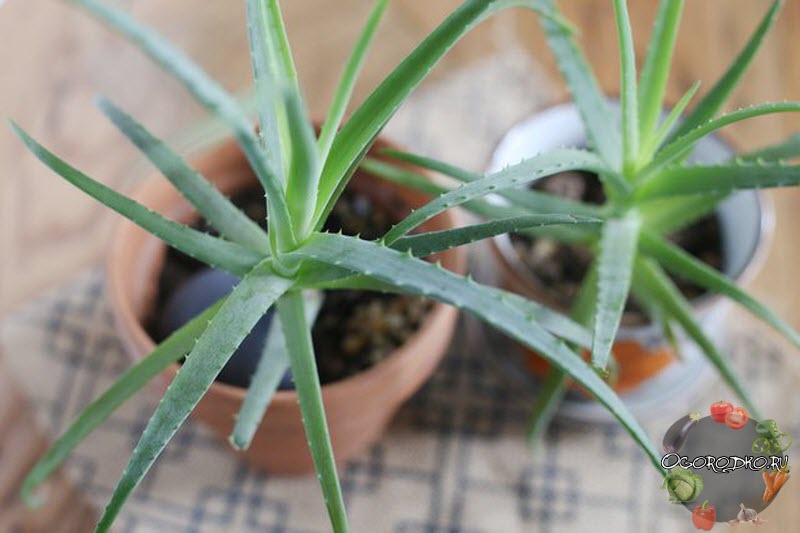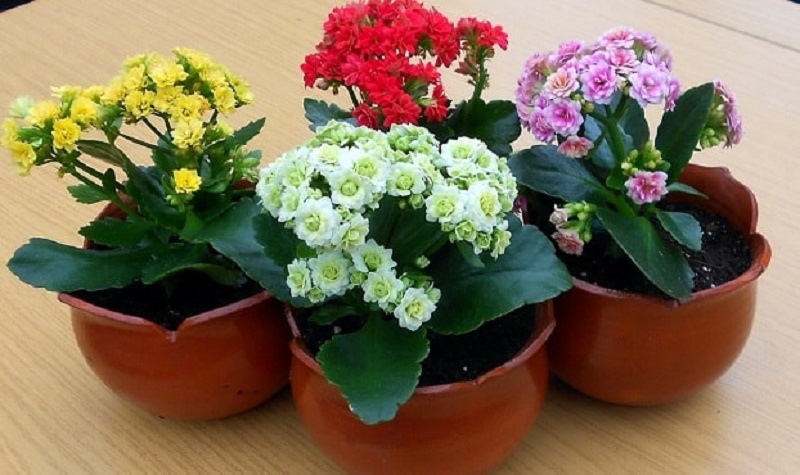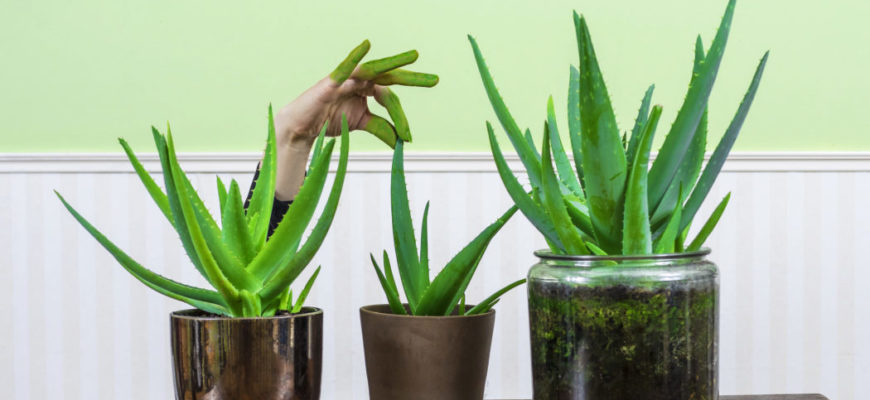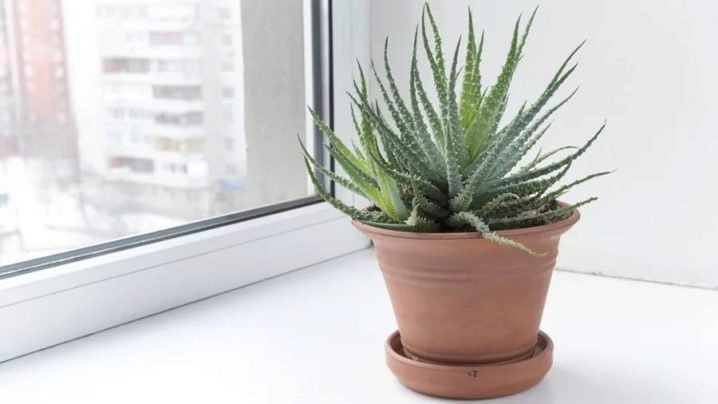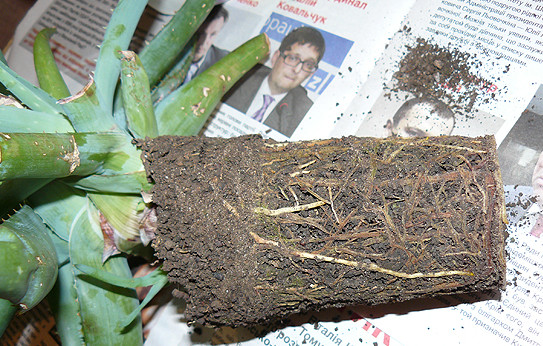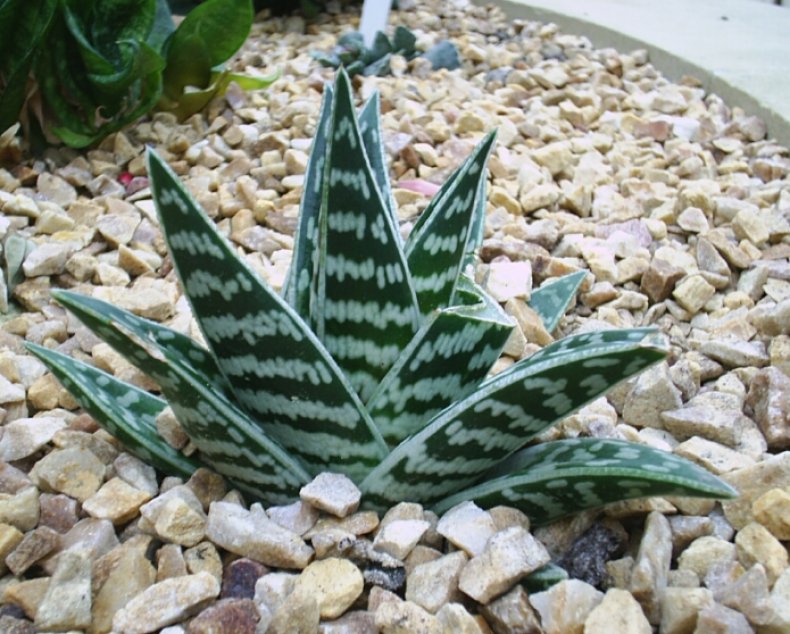How to water a plant
There are two watering methods that are used depending on the age of the succulent:
For young flowers, use the warm water tray method. The pot is placed in a deep container into which the liquid is poured. This is the best option, which helps to preserve all nutrients in the ground. They will not wash out.
Adult plants are watered with a watering can
In this case, it is important to ensure that the liquid does not get on the leaves. If it accumulates in outlets, the aloe will begin to die.
Before the procedure, the soil must be loosened so that it absorbs moisture well.
Important! Aloe should not be sprayed as this can lead to leaf death. If it is necessary to remove dust from the leaves, they are wiped with a cotton pad.
Depending on the season
The rules for caring for the agave depend on the season. The flower needs an increased amount of moisture in the spring. After winter dormancy, he needs it for active growth. During this period, you need to water once every seven days, in the summer the procedure is increased to two times. In autumn and winter, watering is extremely rare, since the succulent will be dormant.
How to water seeds
Aloe can be propagated by seeds. But this is a rather complicated method that I rarely use. In order for them to germinate, you need to do the following:
First, the seeds must be soaked in a weak solution of potassium permanganate, then placed in loosened soil. The distance from one seed to another must be at least two centimeters.
A small layer of sand is poured onto the ground on top.
To moisten the soil, the container is immersed in warm water
It is important that the soil remains always moist before the seeds emerge.
As soon as the seeds sprout, watering begins according to the scheme once every seven days.
Watering the shoots during reproduction
The most common way to propagate aloe at home is by cuttings. This method has its own peculiarity. After cutting, the cuttings must not be immersed in water. They need to be sprinkled with wood ash, kept in the air until the roots appear.
Cuttings can be placed in a pot with moist soil. Before the roots appear, they must be kept like this for several weeks. Once the plant is rooted, it is transferred to a container with dry soil. After transplanting, young plants are not watered.
Attention! It is important to choose the right pot for planting. There should be several holes in it. In addition, it must be wide so that the roots can grow freely.
In addition, it must be wide so that the roots can grow freely.

Most often, aloe is propagated by cuttings.
Watering when transplanting
When transplanting aloe, watering should be stopped within a month. Then the plant is placed in new soil, which is pre-moistened. The flower is not watered for the first week after transplantation.
The number of transplants directly depends on the age of the plant. For a young flower, the soil needs to be changed every two years, for adults no more than once every four years. The procedure should be carried out in the spring, when the plant begins to actively grow.
Important! Naturally, aloe grows in the sand. This moment must be taken into account when growing it at home
The land for the agave must contain sod, sand and leafy ground... A drainage layer is preliminarily laid out on the bottom of the pot.
Popular types of aloe for growing at home
The most popular type of aloe that can be found in almost every apartment is tree-like. Narrow fleshy leaves of this type are used for medical purposes and for cosmetic procedures.With proper care, Aloe arborescens grows up to a meter in height, forming a gorgeous bush. There are thorns only on the leaves, the stem of the flower is smooth, more rigid at the bottom and softer at the crown of the plant. If the flower is not looked after correctly, it begins to rot, the color of the leaves becomes faded, and the tips may turn yellow and dry.

Aloe tree
Aloe vera grows up to half a meter, leaves with thorns, but wider than those of the tree, slightly grooved, bright green. The stem is shortened, the leaves are collected in spirally twisted rosettes. Aloe vera is considered to be one of the most useful plants for humans.

Aloe vera
Variegated aloe is a decorative type of plant that grows to a maximum of thirty centimeters in height. A healthy plant has dark green leaves with irregular white stripes, soft thorns may be present but not required. The leaves are twisted in a spiral, the trunk is very short.
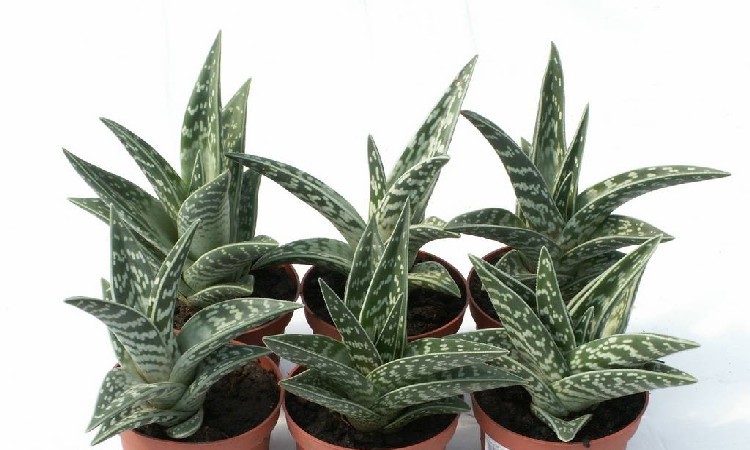
Aloe variegated (tiger)
Spinous aloe is a beautiful decorative succulent, similar in shape to variegated aloe, but instead of white stripes there are small dots on the leaves, and the entire surface of the latter is rough with spines at the tips. The flower of the plant is bright orange, the maximum plant height is 20-30 cm. The plant is unpretentious, but requires proper watering and care along with other types of aloe.

Aloe spinous

Aloe bloom
Aloe watering rules
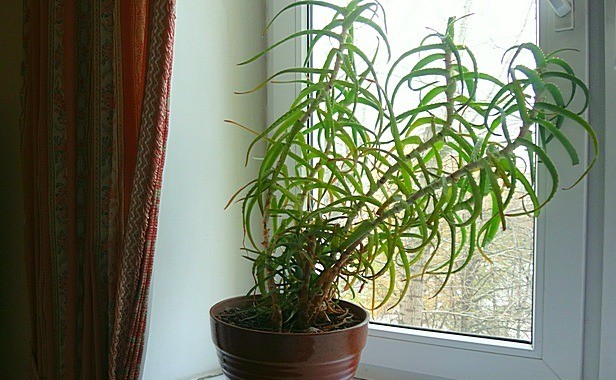
Proper watering of the flower contributes to its good growth.
You can water aloe in different ways, but the main rule is not to flood the flower, otherwise the roots will rot and the plant will die. For the same reason, it is strictly forbidden to pour water into the socket.
Watering from above
Watering from above is carried out from a watering can under the root. Water should be poured until it appears in the sump. Only plentiful watering is relevant, if moisture is applied in small doses, then the lower layers of the soil will remain dry, which will not benefit the plant.
Spraying from above is carried out with a fine atomizer, but this measure is not necessary. If the plant is in the sun, then it is better not to spray it in order to avoid burning the leaves. In the summer, during the day, water is not sprayed onto the leaves.
It is recommended to add a small amount of concentrated aloe juice to the water for irrigation. This natural supplement is completely safe and will promote rapid plant growth.
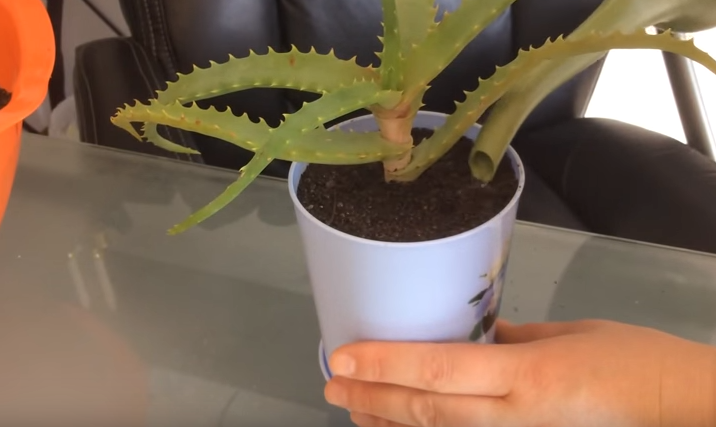
Proper watering of aloe from above
Watering from below
Prepared water is poured into the pan. This method is considered the best, since nutrients are not washed out from the soil, and large roots are not waterlogged. Water is absorbed by small roots.
If there is a large drainage layer in the pot, then it is better to lower the pot in a deep container of water for a few minutes, then let the excess moisture drain and put the aloe back on the tray.

An example of watering flowers using the immersion method
Watering frequency
Watering frequency varies with the season. In summer, the plant is watered every two or three weeks when the potted soil is completely dry. Even if the air in the room is too dry, you should not add excess liquid to the soil. In winter, watering can be reduced to once a month, while keeping the potted soil completely dry.
It is not recommended to often water the flower during a rainy period and with high humidity.
In summer, watering is carried out in the late afternoon, in the cold season, aloe is moistened in the morning.
The age of the flower is also taken into account - the older the aloe, the less often it is watered. Rooting sprouts are watered more often.
And, of course, the frequency of watering depends on the climate in the apartment - the higher the temperature and more light, the more often the plant is moistened.
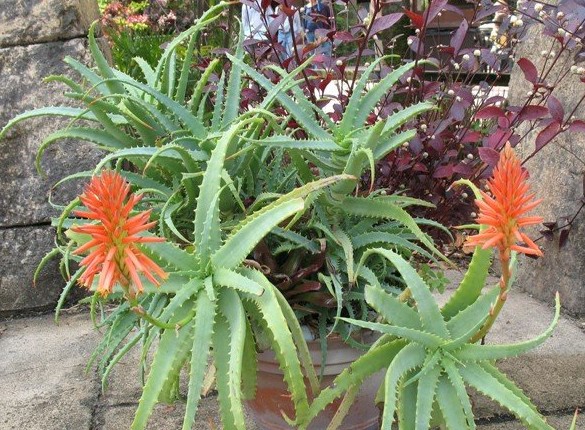
Homemade aloe

Lighting for aloe
The best air temperature for aloe is about 16 degrees, a constant supply of fresh dry air is recommended.
What water is better to use
Aloe is very sensitive to the liquid it absorbs. Do not water the flower with tap water. It can contain a lot of chlorine and other harmful substances.
Irrigation water must meet the following criteria:
- quality. Watering can only be done with absolutely clean water. To do this, typing from the tap, it should be defended for at least a day. During this time, chlorine will evaporate, and heavy impurities will settle to the bottom. In winter, you can use melted snow collected away from highways;
- the temperature changes with the seasons, but is always quite warm. In winter, the liquid should be warmed up so that it is 6-8 degrees above room temperature, in the spring - up to +20. +22 ° С, and +30 in summer. +35 ° C. If you do not want to heat the water, it can be defended in a warm room for several days. It will warm itself up to room temperature;
- acidity. The aqueous medium should be slightly acidic. To do this, it is advised to add a little citric acid or vinegar (3-5 g per 1 liter) to the water.

Frozen water works best for watering aloe.
It is prepared as follows:
- Collect tap water and stand for 12-24 hours.
- Pour the liquid, leaving the sediment at the bottom, into a plastic bottle.
- Place the bottle in the freezer and leave there until the liquid is completely frozen.
- The container is placed in the room to melt the ice.
- Wait for the water to warm to room temperature.
Watering rules for the seasons
There are several periods of vegetation and active growth indoor plants. Watering in each season should be different, only in this case the plants give greenery and bloom brightly.
In winter
First, to understand how often water the plants in winter, there are several conditions to consider. Starting from October-November, most indoor plants begin to go through a dormant period. Growth slows down, metabolic processes too. Therefore, the irrigation regime differs radically from the summer one.
Unfortunately, it is in winter that the percentage of plant loss due to unregulated watering increases significantly. The high temperature in the room gives reason to believe that the soil dries out quickly, and therefore requires maximum moisture. But this is far from the case. The root system works slowly, absorbs moisture weaker than in spring and summer. If it is in excess, the soil sour, the root system is subject to rotting.
If the plants are on cold windowsills, there is a high risk that with excessive watering, the roots will begin to rot, the leaves will turn yellow and wither, since the soil is wet.

During the heating season, it is better to regularly spray the crown of plants with warm boiled water from a spray bottle. Thus, the soil will be moderately moist.
Indoor flowers, which do not require an elevated air temperature, are removed to a cool room and watered about once a month to prevent the earthen coma from completely drying out.
Most plants that bloom in winter should be watered regularly, preferably with lukewarm water. Examples include episodes, Schlumberger (Decembrists), orchids. Bulbous plants are watered as the topsoil begins to dry out.
Succulents are watered carefully in winter, allowing the soil to dry deeply.

In the spring
In the spring, watering should be approached with all responsibility. Since a new growing season begins, daylight hours increase, watering should be more frequent.
If the heating in the apartment has already been turned off, and the temperature outside is low, it will be correct to water the flowers with caution and in moderation. Spraying in the spring should also be included in the comprehensive care of flowers.
It creates the right level of moisture at which the plants are comfortable.

Summer
In the summer, indoor plants develop and grow vigorously. Accordingly, watering should be more frequent and more intensive. In addition, care must be taken to ensure that the potted soil does not dry out completely. At this time, watering can be carried out with water with the addition of various nutrients: succinic acid, hydrogen peroxide, glucose.
Moderate watering in the summer is necessary for cacti, succulents, zamioculcas, fat women, and so on. Abundant watering is required for moisture-loving balsams, begonias, ferns, spathiphyllum and the like.
During abundant watering, the soil in the pot should be saturated with moisture, for this it is watered in small portions several times with an interval of 15-20 minutes. If water seeps into the sump, stop watering.
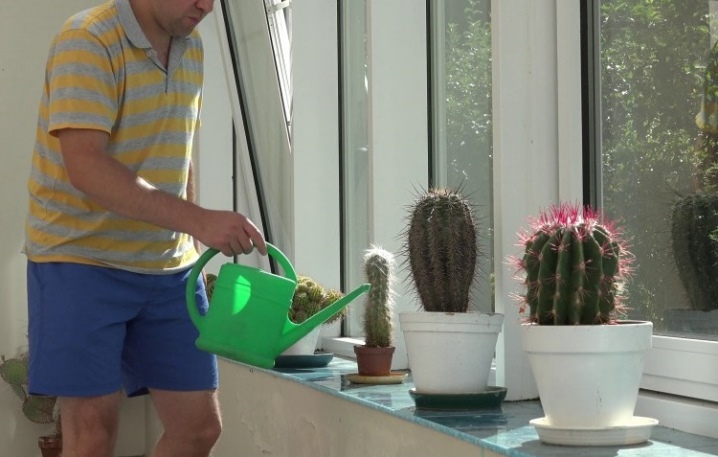
In autumn
Autumn is a transitional season for indoor plants. This is a period of high risks, since daylight hours decrease, the heating season begins, therefore, it is necessary to adjust the watering of flowers.
The main guideline for watering in the autumn is the weather outside the window. If the days are sunny, you need to make sure that the soil does not dry out completely, but if it is cool and cloudy, then it is better to skip watering, wait for the soil to dry out.
Indoor plants require less moisture in autumn than in summer and spring, so even spraying should be taken more seriously.
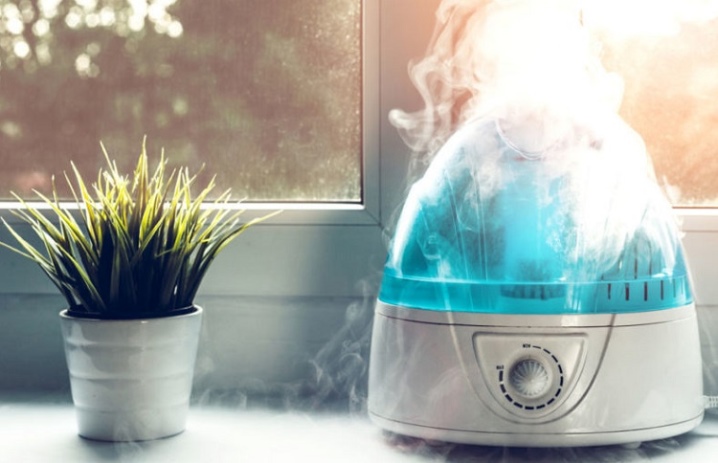
Factors affecting the frequency and abundance of watering
The irrigation schedule and its strength depend on the following external factors:
- Pot material. Anthuriums planted in clay pots always ask for more water, which is explained by the physical properties of clay, which perfectly permits moisture through itself and allows it to evaporate from the outer surface of the pot. Anthuriums planted in plastic need less water when watering.
- Plant age. If the anthurium is young, then the top layer of soil in the pot should always be moistened. An adult plant is comfortable in drier soil.
- Development period. During flowering and activation of growth, anthurium needs a lot of moisture. At the same time, during the dormant period, it is an indication to reduce the volume of irrigation by 2 times.
- Substrate composition. If the anthurium is planted in a moss substrate, then watering must be done as it dries. At home, the dryness of the moss can be determined by lightly rubbing it with your fingers and hearing a slight crackle. And also due to a lack of moisture, the moss begins to turn yellow. At the same time, it is not worth pouring the moss, since there is a danger of rotting the root system of the plant.
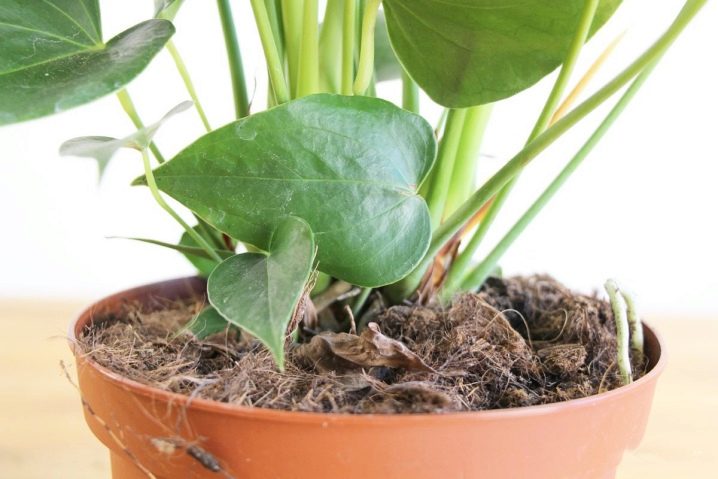
Proper watering - basic requirements
One of the main conditions for the successful growth of aloe at home is proper watering. It should be moderate and neat - otherwise there is a great risk of ruining the plant. From an excess amount of moisture, aloe leaves become lethargic and turn pale. Watering frequency is variable and depends on many factors - air humidity, season. In summer, they are usually watered no more than 1-2 times a week, and even less often in winter. Sometimes aloe is watered once a month.
Step 1. Water the aloe only when the soil in the pot dries up after the last watering. The plant does not tolerate overflow, and in general it is accustomed to drought by nature. To determine if it is time to water, you should feel the soil well - it should be dry a few centimeters from the surface.
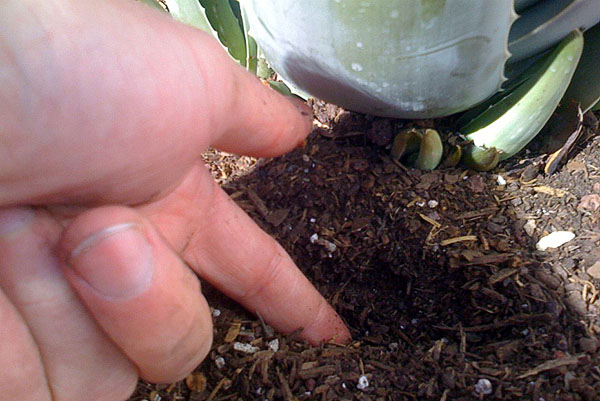
Step 2. If the soil in the pot is dry enough, then the aloe is watered from a watering can with a thin spout - carefully, along the edge of the pot, so that water does not get on the stem or leaves. You don't need to pour a lot of water - just moisten the roots of the plant.


Step 3. Periodically, watering is combined with top dressing. Fertilizers are applied directly after watering or diluted in water.

Step 4. If it is necessary to transplant a plant, its root system is freed from the soil and planted in fresh soil. At the same time, drainage material is laid on the bottom of the pot. If there is no drainage, then the moisture regime will be violated - the soil will dry out for too long, and this aloe does not like.

Watering aloe can be done in two ways - from above and from below. At the same time, the first option, which we described above, is still more popular with florists.Watering from below is done differently: for this, a little water is poured into a small container and a pot with a plant is immersed in it. Water will penetrate through the drainage holes in the planter and moisten the soil. The root system of aloe in this way will be able to get water from the lower layers of the soil.
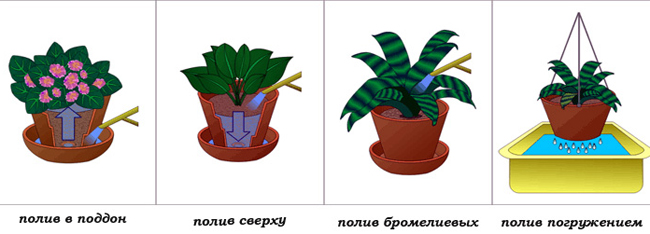
Depending on the season
Each season has its own characteristics of watering the agave.
After winter, the plant needs more moisture, which it needs to grow. In the spring, it is watered once a week, and in the summer, the interval is reduced to twice a week.
In late autumn and winter, the bush requires almost no watering, since it is at rest.
How to water seeds
Seed propagation is a difficult and not the most popular way to propagate aloe.
The germination process is as follows:
- The seeds are soaked in a weak solution of potassium permanganate and placed in a container with previously loosened soil, slightly pressing them into the surface. The distance between them should be about two centimeters.
- A small layer of sand is poured onto the ground.
- The container is lowered into a tray with warm water for a while.
- After moistening the soil, the container is transferred to a warm room. Before the seeds can sprout, the ground must remain moist.
After the first shoots appear, the plant will need to be watered sparingly once a week.
Watering the shoots during reproduction
The easiest way to propagate the agave is by cuttings. After cutting the aloe vera cuttings, they should not be placed in water. The shoots are sprinkled with wood ash and kept in the air until the roots appear.
Another option is to place them in a container of wet sand. This usually takes several weeks. After they are placed in a pot with dry soil. At first, young shoots are not watered.

Transplanted aloe sprout
Important! The pot should have several holes in the bottom for water to drain after watering. A shallow pallet is installed under the pot
Choose a pot that is wide enough or the roots won't grow. The diameter of the pot should be about one-half the length of the aloe leaf.
Watering when transplanting
Before transplanting aloe, it should not be watered for a month. It is necessary to transplant the plant into already moistened soil. Watering for the first week after that is also not recommended.
The frequency of transplanting a succulent depends on the age of the plant. Young aloes are planted once every two years, adults - at four. It is recommended to do this in the spring. It was during this period that the agave is maximally ready for growth.
In nature, aloe grows in sand, and at home it is planted in soil consisting of sand, leafy earth and turf. The soil should be loose and soft. A drainage layer is laid out at the bottom of the pot. For this, you can use any suitable material, for example, broken brick.
Watering vegetables in a greenhouse
If you are growing vegetables in a greenhouse, the approach to watering will be slightly different. Of course, it will also have to be spent during a period when the sun is not so active. Watering frequency depends on the type of soil and plant species. However, greenhouse crops need more watering than those grown outdoors. This is due to the fact that, due to the increased temperature, their stems and leaves wilt much faster.
For watering greenhouse plants, it is permissible to use warmer water. If watering is not correct, excess condensation may form inside the greenhouse, therefore, after the procedure, the greenhouse should be ventilated. Spot irrigation (bottle irrigation) can be used to reduce condensation.
If we are talking about tomatoes and cucumbers grown in a greenhouse, then watering will not differ much from what is carried out in the open field.
First of all, it is important to monitor soil moisture and the appearance of plants. The higher the temperature of the air in the greenhouse, the higher the humidity should be
To do this, you can place containers with water near the beds or spray the plants and walls of the greenhouse.
Do not overdo it with moisture, it is unacceptable that drops of water still remain on the bushes in the evening. For a greenhouse of standard sizes 2 × 3 m, one 20-30 liter barrel will be enough. Pour water into the container as it evaporates. Watering cucumbers before flowering should be carried out every 5-7 days, after completion, once every 2-3 days. The amount of water is 10-20 liters per 1 sq. M.
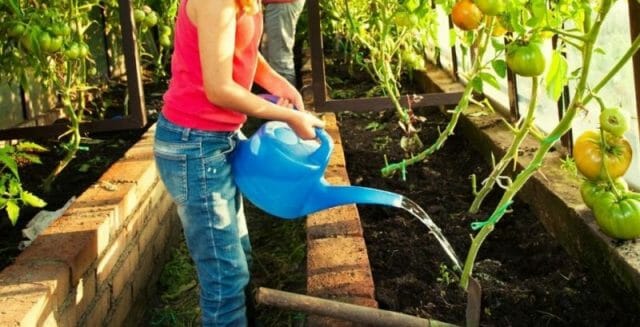
Cucumbers respond well to root watering. The water for these vegetables must be well heated, otherwise there is a risk of fungal diseases. As for tomatoes that are grown in greenhouse conditions, in the first 7 days after planting, they do not need watering. Then they need to be watered every 3-7 days. If the weather is hot outside, the amount of watering can be increased. Before flowering, 1 bush will require 4-5 liters of water, after laying flower brushes, the amount is halved.
For watering vegetables in a greenhouse, it is better to use a watering can with a nozzle. Thus, all plants will receive the right amount of moisture. If vegetables are grown in large quantities, automatic irrigation systems will be required. Summer residents consider the drip irrigation system to be the most economical device, and rainwater is the most technologically complex. If it is too hot in the greenhouse, use a hose to water the lanes with water. This way you can reduce the air temperature.

